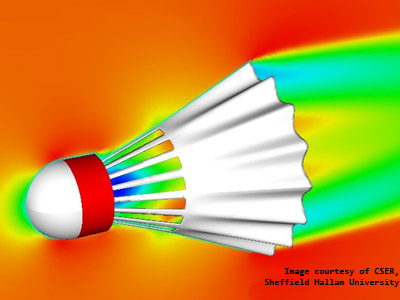Why researchers should avoid reality
Posted on 10 July 2012
Why researchers should avoid reality
 By Simon Choppin, Agent and Postdoctoral researcher, Sheffield Hallam University.
By Simon Choppin, Agent and Postdoctoral researcher, Sheffield Hallam University.
The scientific process can be expensive: rigorous experimental design, advanced equipment, participant recruitment and data collection can all incur significant overheads of time, money and effort. Observing the the subtle workings of our universe is getting costlier, as the things we want to observe become ever smaller or further away.
My work in the field of sports engineering is comparatively straightforward, since the elementary constituents of my research rarely get smaller than a Ping-Pong ball or further away than a football field. However, I am not immune to pressures of time and cost. Wind-tunnels, multi camera systems and radar tracking equipment are neither plentiful or cheap. For this reason, I tend to use software-based modelling as often as possible. Practical experiments are still the gold standard, but a dry run of an experiment in a virtual environment grants us a number of advantages.
- We can observe likely outcomes and anticipate likely practical problems.
- We can generate sets of dummy results to assess the effectiveness of our analysis techniques.
- We can introduce errors of differing types and magnitudes to evaluate the bounds of acceptability for our practical experiment: will less accurate (hence cheaper) equipment suffice?
- We can manipulate the physical parameters of our virtual world to explore a potential experiment quickly and at no cost compared to the physical equivalent. Imagine testing the flight characteristics of new football designs. It's relatively easy to test hundreds of different designs in a virtual environment, but there's a significant cost in creating a hundred prototype footballs and testing each one in reality.
I recently presented a paper at the Physics of Sport conference in Paris regarding a novel method of assessing football aerodynamics. The assessment described in the paper contained only simulated data. The methodology relies on recorded football trajectory data, which not only requires bespoke equipment to obtain reliably in a real environment, but also takes considerable time and resource to obtain. By using a simple ball-flight model (the physics of which are well understood), I was able to create numerous simulated trajectories in a fraction of the time and with no equipment costs.
If creating a virtual environment from scratch is a little extreme, there are numerous simulation packages which look at complex physics systems and some of them are open-source, for example OpenFoam.
Simulation is not always appropriate: every model is a compromised version of reality and the closer we try to get to reality the more complex the modelled system becomes. If your work requires a particularly high level of data fidelity it may take more time and expense to create the model than to take the measurements from the real-world system. Of course, this isn’t always possible, as exemplified by the collaborative, super-computer-based climate models, which need to make predictions far into the future with a variety of changes to the environment. As software and computing power becomes more powerful, the virtual environments we can use to experiment in will not only become more complex, but easier to create. The future looks rosy for scientists keen to avoid reality.

